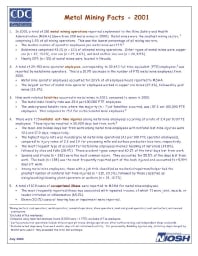Mining Publication: Metal Mining Facts - 2001
Original creation date: July 2003
Authors: National Institute for Occupational Safety and Health
In 2001, a total of 281 metal mining operations reported employment to the Mine Safety and Health Administration (MSHA) (down from 309 metal mines in 2000). Metal mines were the smallest mining sector, comprising 1.9% of all mining operations. This was the lowest percentage of all mining sectors. The median number of operator employees per metal mine was 17.5. Gold mines comprised 43.1% (n = 121) of all metal mining operations. Other types of metal mines were copper ore (n = 37, 13.2%), iron ore (n = 27, 9.6%), and lead and/or zinc ore (n = 24, 8.5%). Nearly 20% (n = 55) of metal mines were located in Nevada. A total of 29,453 mine operator employees, corresponding to 30,640 full-time equivalent (FTE) employees, was reported by metal mine operators. This is a 10.9% decrease in the number of FTE metal mine employees from 2000. Metal mine operator employees accounted for 10.9% of all employee hours reported to MSHA. The largest portion of metal mine operator employees worked in copper ore mines (27.3%), followed by gold mines (26.9%). 3. Nine work-related fatalities occurred in metal mines in 2001, compared to seven in 2000. The metal mine fatality rate was 29.4 per 100,000 FTE employees. The underground fatality rate, where the majority (n = 7) of fatalities occurred, was 157.3 per 100,000 FTE employees. This compares to 15.2 for surface metal mine employees. 4. There were 735 nonfatal lost-time injuries among metal mine employees occurring at a rate of 2.4 per 100 FTE employees. These injuries resulted in 30,929 days lost from work. The mean and median days lost from work among metal mine employees with nonfatal lost-time injuries were 42.1 and 17.0 days, respectively. The highest injury rate was in underground metal mine operations (4.1 per 100 FTE operator employees), compared to injury rates of 2.3 and 1.9 for processing mills and surface production locations, respectively. The most frequent type of accident for metal mine employees involved handling of materials (34.8%), followed by slips and falls (28.4%). These accident types comprised 60.1% of the total days lost from work. Sprains and strains (n = 382) were the most common injury. They accounted for 55.5% of the days lost from work. The back (n = 158) was the most frequently reported part of the body injured and accounted for 5,994 days off work. Among metal mine employees, those with a job title classified as mechanic/repairman/helper had the greatest number of nonfatal lost-time injuries (n = 215, 29.3%), followed by those classified as sizing/washing/cleaning plant operators or workers (n = 93, 12.7%). 5. A total of 109 cases of occupational illness were reported to MSHA for metal mine employees. The most frequently reported illness was associated with repeated trauma, of which 71 were joint, muscle, or tendon irritation or inflammation (65.1%). Eleven (10.1%) cases of hearing loss or impairment were reported.

- Coal and metal/nonmetal mining facts - 2008
- Coal and Metal/Nonmetal Mining Facts - 2008 (HTML)
- Coal Contractor Mining Facts - 2001
- Coal Contractor Mining Facts - 2002
- Coal Contractor Mining Facts - 2003
- Coal Contractor Mining Facts - 2004
- Coal Contractor Mining Facts - 2005
- Coal Contractor Mining Facts - 2006
- Mining Fact Sheets
- Rib Falls: A Major Ground Control Issue